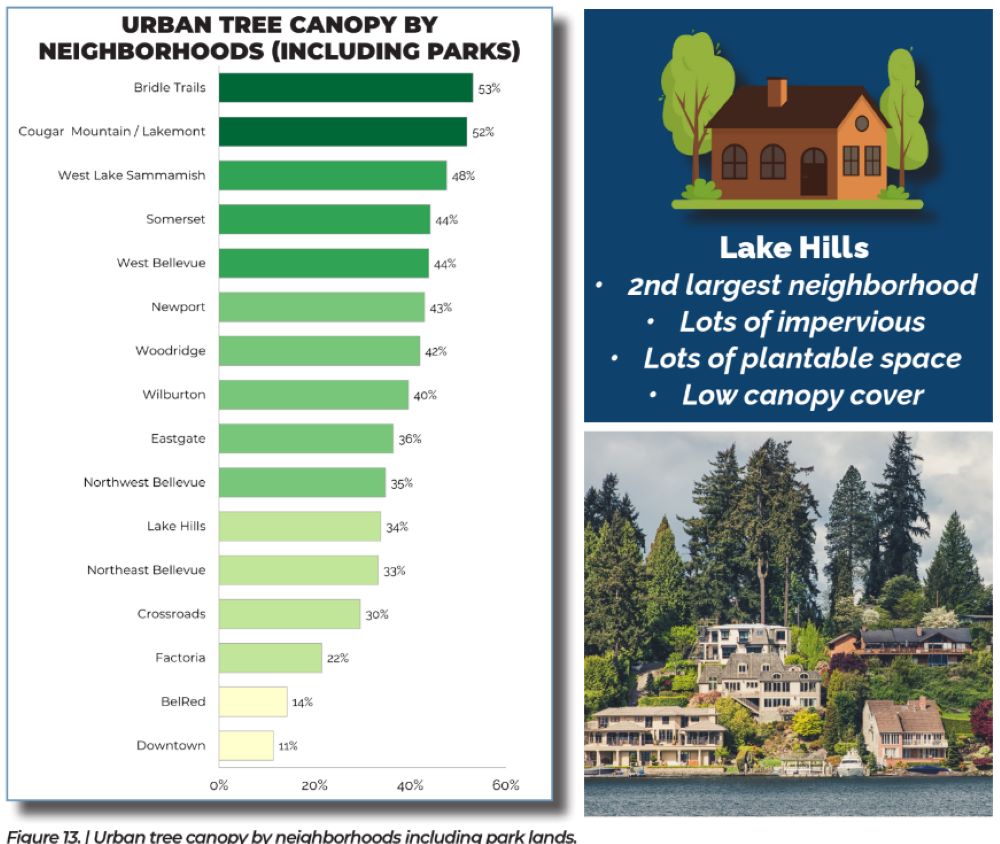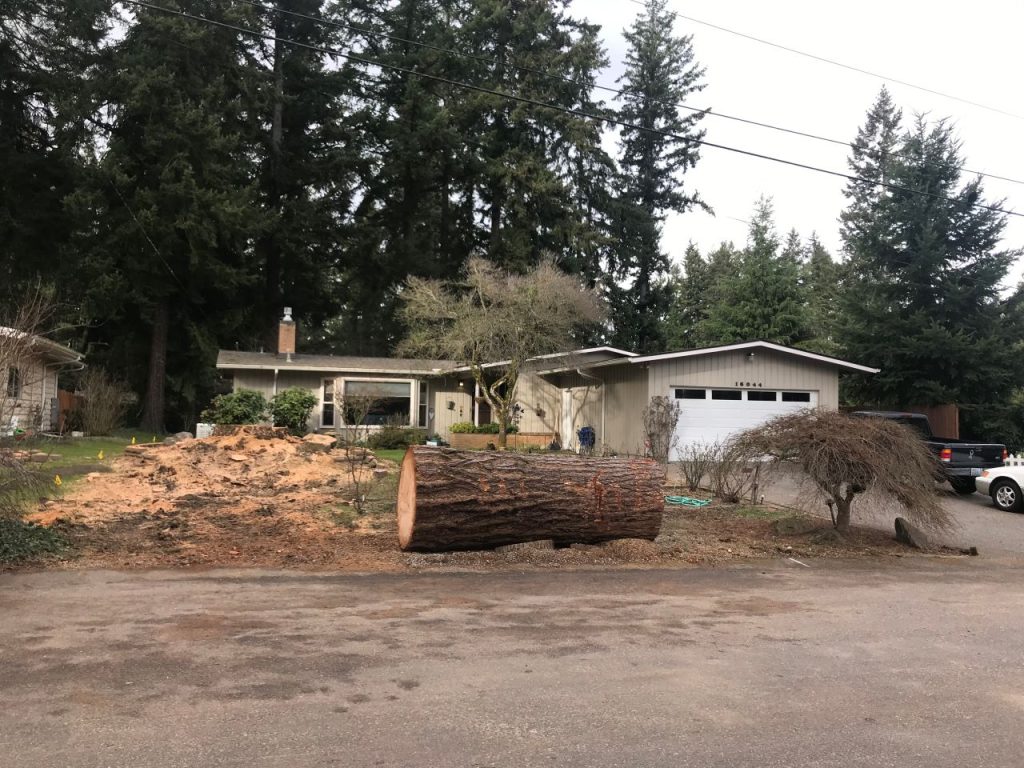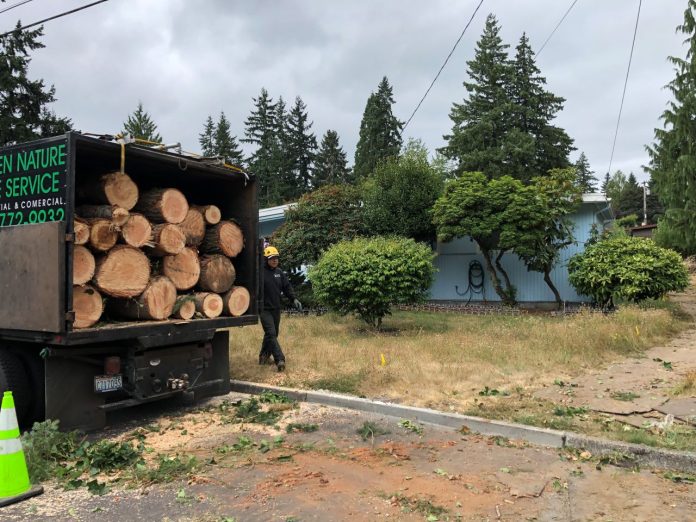
The City of Bellevue has had a goal of reaching 40% tree canopy coverage since its 2015 Comprehensive Plan. If you’ve been following the reports the city has commissioned as far back as 2011, it would seem like things are going quite well. The canopy numbers have been steadily rising – 37% in a study released in 2018, 39% in a study released in mid-2022, and 40% in the most recent study from December 2023. But that doesn’t tell the whole story: Pressing questions remain about whether that tree canopy is equitably distributed, and if protections are in place to maintain tree canopy coverage into the future.
There is reason to doubt Bellevue has achieved 40% tree coverage. The most recent study was based on an analysis of 2021 imaging data; diving a little deeper into the findings showed alarming trends on where the tree canopy was dropping, even as the overall canopy number was going up. Middle class neighborhoods facing “McMansion” style development are seeing the largest losses of tree coverage.
In each report, tree coverage was analyzed across six different land use types: industrial, central business district, parks, commercial & mixed use, urban residential, and suburban residential. Unsurprisingly, the central business district had the lowest tree canopy at 11%, and parks had the highest at 75%. Parks also had the highest growth of canopy percentage at 2.4%, but considering that parks cover less than 12% of the city’s land area, that didn’t have as much impact on the city’s overall numbers.

Bellevue has 66% of its land area designated as “Suburban Residential” use, so obviously that’s where most of the trees are found. From 2018 to 2021, the tree canopy in those areas grew by a couple percent with each new report. But a combination of housing demand that rose steeply during the pandemic, mid-century houses nearing the end of their useful lifespans, and lax city ordinances, led to a 6.5% drop in tree canopy in residential neighborhoods between 2019 and 2021. The concentration of redevelopment in certain areas of the city (for instance, Enatai, Eastgate and Sherwood Forest) has made the loss of greenery especially noticeable.
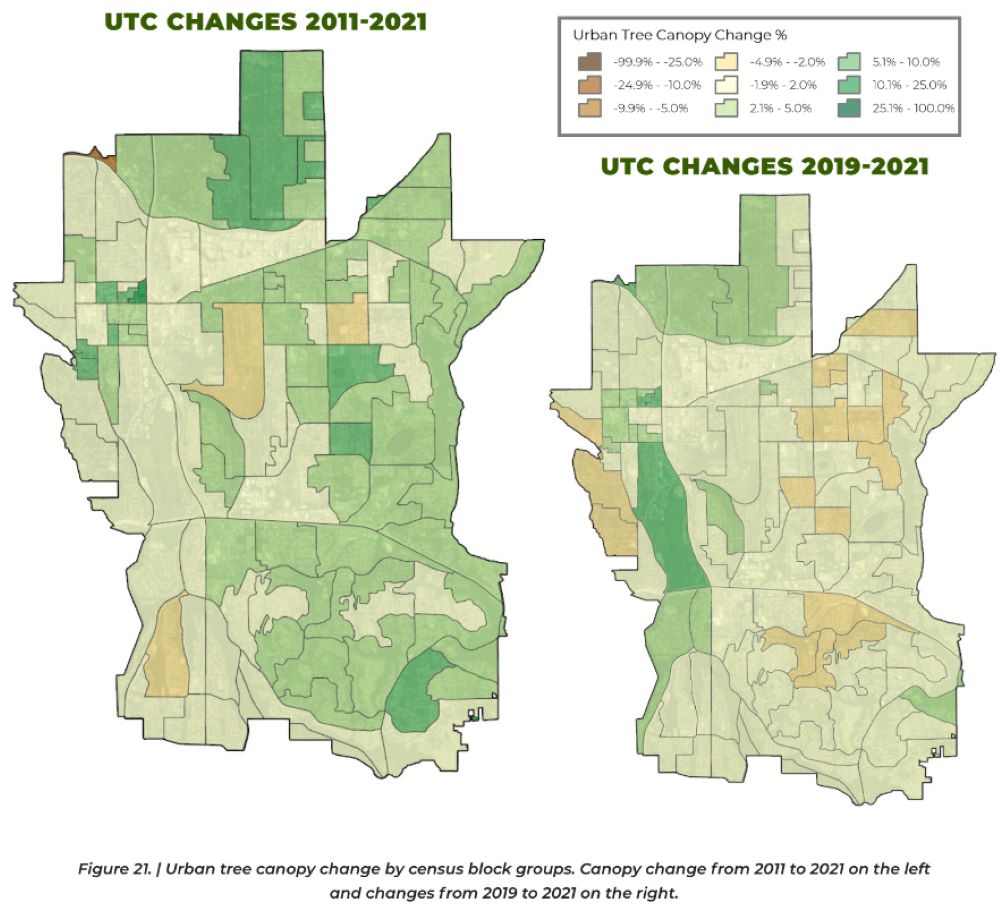
Bellevue has seen an emerging trend of a high number of older homes being torn down and replaced with mansions. The new houses were often more than double the size of the houses they replaced, and builders often took down most or all of the trees on the lot in the construction process due to lax rules and enforcement.
The previous requirements allowed builders to keep just 30% of existing “tree diameter inches,” and homeowners could take down up to five significant trees per year without a permit. Some developers pressured owners to take down large trees before a lot sale closed, followed by the developer taking down 70% of what was left, and a new home buyer could take out remaining trees after the sale. The rules provided no incentives to do anything but cut more and more trees.
The 2023 study showed that neighborhoods with the greatest loss of tree canopy were exactly the ones where residents have seen the oldest (and least expensive) houses being torn down: Lake Hills, Eastgate, and Northeast Bellevue. And given that the data only went up to 2021, it’s very clear that the loss of trees has not waned in the intervening years.
How the tree ordinance came together
In response, the community and city leaders came together for a holistic system to preserve more trees while allowing additional housing. Bellevue resident Khaiersta English founded Trees4Livability (T4L) in 2022 to advocate for better tree protections. (Full disclosure: I am a board member of Trees4Livability, in addition to serving as board president at The Urbanist.) The group began by reviewing the tree codes of other cities in the region, compiling a list of best practices that Bellevue should adopt. Through outreach to neighbors, the group gathered over 1,700 petition signatures asking for specific improvements to the city’s tree ordinances.
In addition to Mayor Lynne Robinson and Councilmember Janice Zahn, T4L found allies in city staff. This included Planning Manager Kristina Gallant, who was willing to explore innovative solutions. One goal of the update was to protect trees while following new land use rules (required by HB 1110) that will allow more housing density options in residential areas. The city hosted a briefing and feedback session on the proposal with the business-focused Bellevue Development Committee in January of this year, and took input on how to improve the proposal from the Master Builders Association, affordable housing developers, and community members. All that groundwork is bearing fruit this summer.
On July 9, the Bellevue City Council unanimously adopted new Land Use Codes and Bellevue City Codes, making the first major changes to tree ordinances in over 40 years. Those changes took full effect on August 10.
Under the new codes, there are now limits on how many trees a homeowner may remove each year, a permit is required to remove any trees larger than six inches in diameter, and trees must be replanted if there aren’t enough trees left on the lot to meet the city’s canopy goals. For properties being redeveloped, there’s a three-year lookback that requires any trees removed earlier to be replaced, there’s a minimum tree density requirement that strongly incentivizes keeping larger mature trees, and there is indefinite protection on any trees that were required to be kept or planted to meet the new density requirement.
For a more in-depth overview of the legislation, see the summary at the end of the article.
The significance of Bellevue’s new tree code
These changes are a huge step forward for Bellevue and the region. Other cities should look closely at what Bellevue has accomplished, as they also try to protect their urban forests while expanding housing and making room for a growing population.
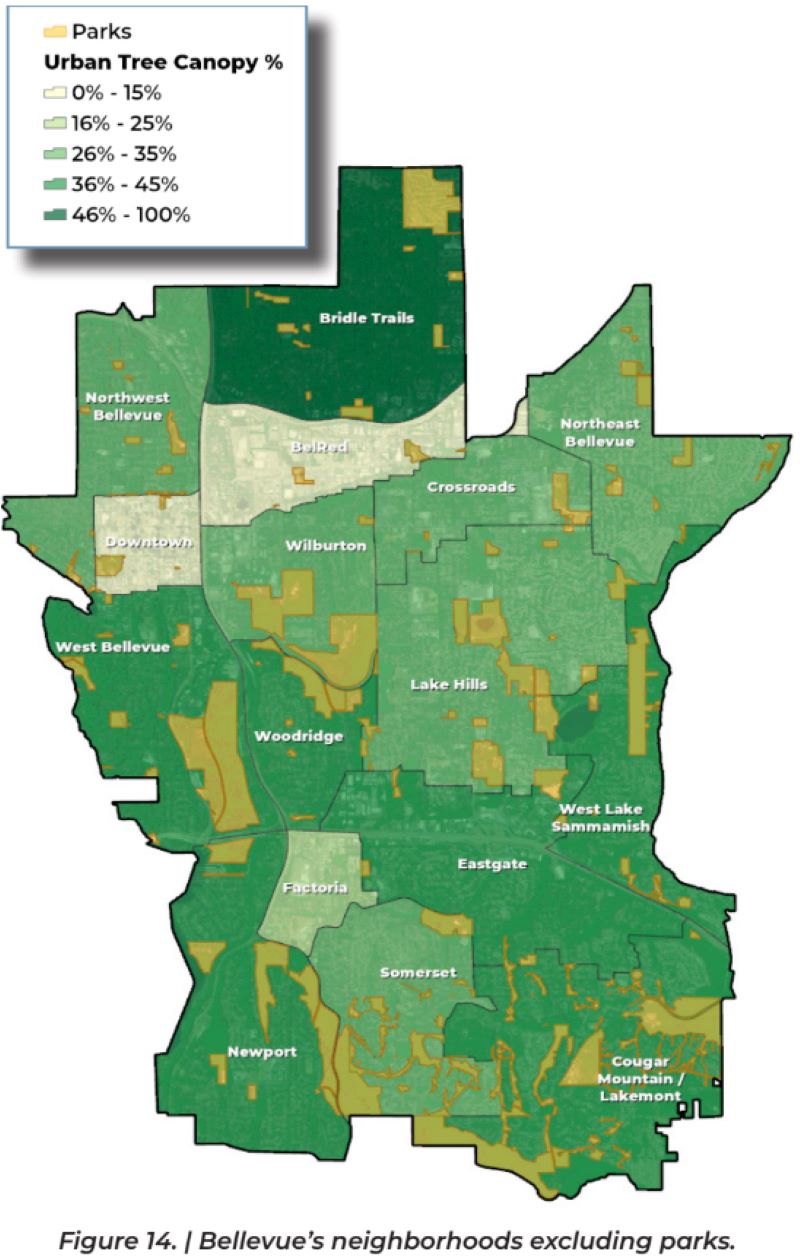
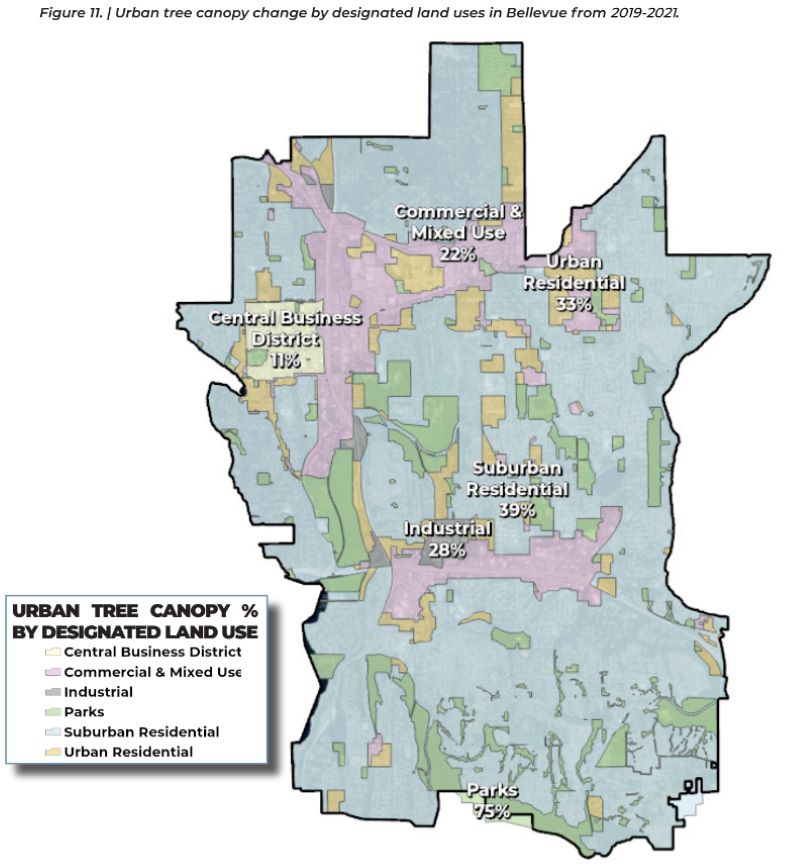
Of course, there is always room for future improvement. The Council has agreed to revisit and make adjustments during next year’s discussion of the Comprehensive Plan update. As was pointed out by Councilmember David Hamilton during council deliberations, allowing one huge Landmark tree to be taken out every year seems excessive; the time period should be extended to three or more years.
In other areas of city policy, the city should require both commercial and residential developers to plant street trees in right-of-ways to mitigate heat island effects that are only getting worse. There should also be additional incentives for planting groves of trees, as groups of trees are healthier and provide more valuable habitat than individual trees spaced apart.
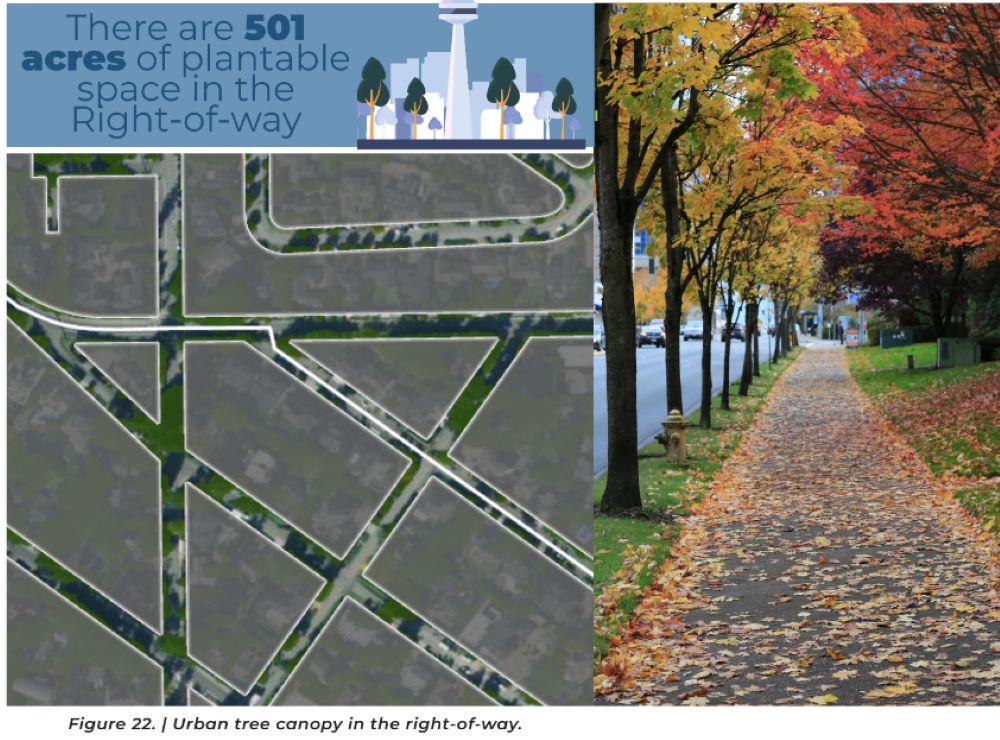
Rules must be enforced to be effective, and the City should develop a public-facing portal where residents can see which trees have been permitted to be removed, and the City must devise a mechanism to report and block illegal tree removals. The city must also step up targeted tree planting programs in the specific neighborhoods of Factoria and Lake Hills, economically less-advantaged neighborhoods that have historically had the lowest tree canopy and the highest temperatures.
Bellevue deserves congratulations on its new tree codes. It has required a lot of effort from many players to get this far, but residents now and long into the future will thank those who protected the city’s green legacy. They will thank even more the leaders who continue to improve tree protections and tree canopy enhancements in the coming years.
A summary of Bellevue’s new tree ordinances
These rules do not apply in Critical Areas or Shoreline districts; those areas have separate rules that are more strict. The rules also don’t apply to the Downtown or East Main land use districts, which have their own incentive-based systems for promoting tree planting during redevelopment.
Definitions:
- Viable Tree – a tree rated as being in fair, good, or excellent condition by a certified professional arborist using national appraisal criteria.
- Hazardous Tree – a tree with a high to extreme risk rating, with a high probability of failure, that is located where it may injure people or damage property, and that cannot reasonably be made less hazardous.
- Significant Tree – a viable tree that’s at least 6 inches in diameter measured at 4.5 feet above the ground.
- Landmark Tree – a viable tree that’s at least 24 inches in diameter measured at 4.5 feet above the ground. The city has a list of specific native trees, such as madrone, which are considered Landmark trees when they have smaller diameters of 8 to 12 inches. Alder and cottonwood trees are never Landmark trees, no matter how large.
- Required Minimum Tree Size – Any time trees are required to be planted, they must have at least a 2-inch diameter trunk (for deciduous trees) or be six feet in height (for conifer trees.)
- Tree Credits for Planted Trees – Each planted tree that is at least the minimum size provides one tree credit. There are no credits given for smaller trees, or for alders or cottonwoods.
Removing trees Without Other Construction
In order to remove trees from a residential lot (meaning lots with zoning from R-1 up to R-30), the owner needs to apply for a simple type of clearing and grading permit. The city has set a maximum number of Significant and Landmark trees that may be removed from a property in any 12-month period, and has also set a minimum number of trees that must remain on the property. The maximum and minimum numbers are based on the size of the property: the larger the lot, the more trees that may be removed, but also the higher the number of trees that must remain or must be replanted.
Here are the rules specifying how many trees may be removed, and how many must remain in order to avoid replanting:
- Up to 10,000 square feet lots: 1 landmark or 2 significant trees may be removed, as long as 2 significant or landmark trees remain on the site.
- 10,001 to 20,000 square feet: 1 landmark or 3 significant trees may be removed, as long as 3 significant or landmark trees remain on the site.
- 20,001 to 40,000 square feet: 1 landmark or 4 significant trees may be removed, as long as 4 significant or landmark trees remain on the site.
- 40,001 square feet or greater: 1 landmark or 4 significant trees may be removed, as long as 8 significant or landmark trees remain on the site.
If the number of remaining trees after removals is less than the minimum required, new trees must be planted. The new trees must be on the same lot as the removed trees. For each Significant tree that was removed, one new tree must be planted. For each Landmark tree removed, three trees must be replanted, or two trees if they are an approved large conifer species.
A permit is also required before removing more than 25% of the live crown of any Significant or Landmark tree. There is a flat fee for any tree-removal permit and a flat fee for any inspections that are required to grant the permit.
Any trees that were required to be kept or required to be planted as part of a building permit must be kept indefinitely, unless the tree(s) are found to be hazardous by a certified professional arborist. In this case, the trees need to be replanted.
Removing trees during development
When a property owner wants to do major construction, the city reviews the large trees on their site. In order to receive clearing and grading permits, owners are required to preserve existing trees or plant enough new trees to meet a minimum tree density on the property. By requiring owners to increase the number of trees on each redeveloped lot, Bellevue is trying to reach its citywide goal of 40% tree canopy coverage. These rules apply to all residential, commercial, and industrial properties in the city.

An owner of property with very few existing trees is required to plant and maintain new trees, while an owner of property with a high number of trees is allowed to remove trees if needed. The rules incentivize owners to save existing large trees by counting much more towards the required minimums than newly planted trees. Any trees taken down within three years of applying for a redevelopment permit must be replaced as part of the plan, with one new tree planted for each Significant tree removed and three new trees planted for each Landmark tree removed. This rule discourages owners from clearing trees before selling to a developer.

To meet the required minimum tree density on a property, the owner must obtain a number of “tree credits” for each 1,000 square feet of lot size. The required density is based on the size of the entire lot, including the area occupied by buildings. The number of credits needed per 1,000 square feet ranges from a high of 5.0 for the largest (R-1) lots with one single family house, down to 0.75 for the smallest lots or multifamily residential properties. Non-residential uses like commercial and industrial zoning require between 0.5 and 1.0 tree credits per 1,000 square feet.
Tree credits are earned in two ways: by preserving existing trees or by planting new trees. Existing trees are given credits based on their size. A 6-inch diameter tree (a Significant tree) is worth 2 tree credits; larger trees are worth more, up to a maximum of 10 tree credits for a 24-inch or larger (Landmark) tree. Planting a new tree is always worth just one tree credit. If all options are considered and it’s infeasible to plant enough new trees, the city may allow a developer to pay a $1,300 fee for each tree credit, in lieu of planting trees. This money is used to enhance the city’s tree programs.
If a lot doesn’t already have enough tree credits to meet the standard, then existing significant and landmark trees may only be removed in limited circumstances; for instance, if a tree prevents access to the property or is in the way of utility connections. The city can agree to relax certain restrictions, including required parking, in order to provide maximum development capacity in order to protect groves and/or Landmark trees. The lots must still exceed the required minimum tree density. Developers will be able to reduce front yard setbacks by up to 50%, reduce rear yard setbacks by up to five feet, and add an additional 12 feet of building height if it’s at least 20 feet from a property line. Affordable housing developers will also have this flexibility, as long as the minimum tree density is still provided on the lot.
As an example of how tree credits work, consider a 30,000 square foot (3/4 acre) suburban lot with one house, as commonly found in the Bridle Trails neighborhood. In order to build a new single family house, this R-1 zoned lot would be required to have 5 tree credits per 1,000 square feet of lot size, for a total of 150 tree credits. The owner could plant 150 new trees (worth one credit each), or preserve 15 landmark trees (worth 10 credits each), or do a combination of preserving and planting.
A 7,500 square foot lot in a more affordable neighborhood like Lake Hills may have an owner who wants to build a duplex. The R-5 zoning with two dwelling units would require 1.5 tree credits per 1,000 square feet, or 11 tree credits total. The owner could plant 11 new trees or preserve three 12-inch diameter trees (worth 4 credits each), or one Landmark tree (10 credits) and one Significant tree (2 credits.) In most cases, saving existing large trees will make more sense than planting new trees.
During construction, trees that are being kept must be protected by following a tree protection plan prepared by a certified professional arborist. Tree protection must be in place for the entire duration of construction, through the final inspection.
These rules only apply when an owner applies to redevelop a piece of property. No one is required to plant new trees on an existing lot. except during redevelopment or when applying to remove trees on a lot that doesn’t have enough remaining trees.
Enforcement and Fines
Removing significant or landmark trees on private property may result in a fine that’s a minimum of $1,300 or the appraised value of each tree, whichever is greater. If it is a repeat violation, the fine may be doubled.
Removing or damaging trees on city property may result in a fine that’s a minimum of $1,300 or triple the appraised value of each tree, whichever is greater. The violator must also pay any costs related to the investigation.
Fines for illegal tree removals are based on the appraised value of the tree(s). If a tree’s trunk is less than 6-inches in diameter, the appraised value is the direct cost to replace it. Significant and Landmark trees are appraised by calculating the area of a cross-section of the trunk when measured at 4.5 feet above ground, and then multiplying it by a “unit tree cost” that is set by the national Council of Tree and Landscape Appraisers. This unit cost can be anywhere from $20 to $100 per square inch, depending on the species and the health of the tree; the appraised value of a single tree could be thousands or tens of thousands of dollars.
When fines are assessed for illegal tree removals, the City Hearing Examiner may increase the fines for repeat violations, violators who do not cooperate with the investigation, or other aggravating factors. Reports of violations can be made through the MyBellevue phone app, the MyBellevue webpage, or to the City of Bellevue’s Code Compliance office at 425-452-2047 or codecompliance@bellevuewa.gov.

Ruth Lipscomb
Ruth Lipscomb is a board member of The Urbanist. She is passionate about removing the structural barriers that prevent our communities from having nice things. In 25 years of activism, she’s worked on issues including education funding, progressive taxation, expanding democracy, and she once ran for office. Ruth is a retired software engineer who lives in Bellevue in a single-family neighborhood that would certainly be even better with backyard cottages and duplexes.

